“Anyone who says that the Prophet is black should be killed”: The ...
“Anyone who says that the Prophet is black should be killed”: The ...
“Anyone who says that the Prophet is black should be killed”: The ...
Create successful ePaper yourself
Turn your PDF publications into a flip-book with our unique Google optimized e-Paper software.
throne in 801 by Tu Yu; and in <strong>the</strong> T’ang H<strong>is</strong>tory, <strong>the</strong> official dynastic h<strong>is</strong>tory of <strong>the</strong> T’ang<br />
completed in 945. In <strong>the</strong>se notices <strong>the</strong> Arabs (called <strong>the</strong>re Ta-shih) encountered during <strong>the</strong> Yunghui<br />
period (650-656) are descri<strong>be</strong>d: “<strong>The</strong> Arab country was originally part of Persia. <strong>The</strong> men<br />
have high noses, are <strong>black</strong> and <strong>be</strong>arded.” 88<br />
Descriptions of <strong>the</strong> Arab conquerors of <strong>the</strong> West are similar. In <strong>the</strong> French epic poem<br />
Song of Roland (wr. ca. 1100), Sir Roland’s Saracen enemies at <strong>the</strong> Battle of Roncevaux (778) are<br />
descri<strong>be</strong>d as “hordes <strong>black</strong>er than <strong>the</strong> <strong>black</strong>est ink – no shred of white on <strong>the</strong>m except <strong>the</strong>ir<br />
teeth.” 89 Roland fur<strong>the</strong>r descri<strong>be</strong>s <strong>the</strong> Saracen commander:<br />
at <strong>the</strong>ir head rides <strong>the</strong> Saracen…no worse criminal rides in <strong>the</strong>ir company, stained with <strong>the</strong><br />
marks of h<strong>is</strong> crimes and great treasons, lacking faith in God, Saint Mary’s son. And he <strong>is</strong><br />
<strong>black</strong>, <strong>black</strong> as melted pitch…90<br />
In a miniature from Charles V’s Grandes chroniques de Franch (ca. 1370s) Roland’s Saracen<br />
enemies are depicted <strong>black</strong>-skinned – though handsome – in contrast to <strong>the</strong> white faces of<br />
Roland and h<strong>is</strong> charging Chr<strong>is</strong>tian knights. 91 While it <strong>is</strong> certainly true <strong>that</strong> <strong>the</strong>se depictions<br />
employ a symbolic convention <strong>that</strong> seeks to contrast <strong>the</strong> dark (sinful) from <strong>the</strong> (white) virtuous, 92<br />
<strong>the</strong>y no doubt reflect a h<strong>is</strong>torical reality as well. Th<strong>is</strong> <strong>is</strong> confirmed by details relating to <strong>the</strong> Arab<br />
conquest of Egypt.<br />
<strong>The</strong> conquest of Egypt by <strong>the</strong> Arab Muslims in 641 was in <strong>the</strong> main carried out by darkskinned<br />
Arabs. 93 <strong>The</strong> second caliph <strong>who</strong> authorized <strong>the</strong> conquest, #Umar b. al-Khaãã§b (d.<br />
23/644), was a QurayshÊ Arab with African ancestry. Not only was h<strong>is</strong> mo<strong>the</strong>r from <strong>the</strong><br />
exceptionally dark Banå "l-MughÊra, but h<strong>is</strong> paternal grandmo<strong>the</strong>r was an enslaved Ethiopian. 94<br />
<strong>The</strong> caliph himself has <strong>be</strong>en descri<strong>be</strong>d as a bald, <strong>black</strong>-skinned man (rajul §dam) as if he were<br />
from <strong>the</strong> Banå Sadås. 95 <strong>The</strong> troops were mainly Yemeni Arabs, <strong>who</strong> are noted for <strong>the</strong>ir dark<br />
88 Ro<strong>be</strong>rt G. Hoyland, Seeing Islam As O<strong>the</strong>rs Saw It: A Survey and Evaluation of Chr<strong>is</strong>tian, Jew<strong>is</strong>h<br />
and Zoroastrian Writings on Early Islam (Princeton, NJ: <strong>The</strong> Darwin Press, INC., 1997): 245, 250.<br />
89 <strong>The</strong> Song of Roland, trans. Frederick Goldin (New York: W.W. Norton, 1978) 99.<br />
90 Song of Roland, 107.<br />
91 See Rita Lejeune and Jacques Stiennon, <strong>The</strong> Legend of Roland in <strong>the</strong> Middle Ages 2 vols. (New<br />
York: Praeger Publ<strong>is</strong>hers, 1971), I: 288 and plate 41B; Strickland, Saracens, demons, & Jews, 179-180.<br />
92 Strickland, Saracens, demons, & Jews, 169.<br />
93 Th<strong>is</strong> seems also to <strong>be</strong> <strong>the</strong> case with regard to <strong>the</strong> conquest of Syria. <strong>The</strong> famous Khālid b. al-Walīd (d. 21/642),<br />
<strong>who</strong> led <strong>the</strong> Syrian expedition, was from <strong>the</strong> exceptionally <strong>black</strong> Banå l- MughÊra (EI 2 VI:138 s.v. Makhzåm by M.<br />
Hinds). Many leaders at <strong>the</strong> dec<strong>is</strong>ive Battle of Yarmåk (14/636), <strong>be</strong>sides Kh§lid, were <strong>black</strong>-skinned Arabs, like<br />
#Amr b. al-#$ß and Abå l-A#war b. Sufy§n from <strong>the</strong> exceptionally <strong>black</strong> Banå Sulaym. Many SulaymÊs participated.<br />
On Abå l-A#war and <strong>the</strong> <strong>black</strong> Sulaym see Michael Lecker, <strong>The</strong> Banå Sulaym: A Contribution to <strong>the</strong> Study of<br />
Early Islam (Jerusalem: Hebrew University, 1989) 140, 242-245; EI 2 IX:818 s.v. Sulaym by M. Lecker; al-JaÈií,<br />
Fakhr al-såd§n #al§ al-bidan, 219 (Ar.), 23 (Eng).<br />
94 MuÈammad b. HabÊb, Kit§b al-Muhabbar, ed. E. Lichtenstädler (Hyderabad, 1361/1942) 306.<br />
95 Ibn Sa#d’s entry on th<strong>is</strong> caliph, al-•abaqāt al-kubrā III/i, 234-235, presents d<strong>is</strong>agreement over #Umar’s<br />
appearance. It <strong>is</strong> reported on <strong>the</strong> authority of both Zirr b. \ubaysh and Hil§l b. #Abd All§h <strong>that</strong> he was <strong>black</strong>skinned.<br />
On <strong>the</strong> o<strong>the</strong>r hand, #Abd All§h b. #$mir and, surpr<strong>is</strong>ingly, <strong>the</strong> caliph’s famous son #Abd All§h reportedly<br />
claimed <strong>that</strong> he was extremely white-complexioned (abya∙ amhaq ta#låhu Èumra). But #Abd All§h b. #Umar <strong>is</strong> himself<br />
descri<strong>be</strong>d as <strong>black</strong>-skinned (§dam; al-DhahabÊ, Siyar, III:209). According to h<strong>is</strong> own <strong>black</strong>-skinned son (<strong>the</strong> caliph’s<br />
<strong>black</strong>-skinned grandson) S§lim b. #Abd All§h, Ibn #Umar said regarding th<strong>is</strong> family <strong>black</strong>ness: “We inherited our<br />
<strong>black</strong> complexion (al-udma) from our maternal uncles.” Ibn Sa#d, al-•abaqāt al-kubrā III/i, 235. Ibn #Umar’s<br />
mo<strong>the</strong>r was Zaynab b. Maí#ån from <strong>the</strong> Jumah clan of <strong>the</strong> Quraysh. On <strong>the</strong> <strong>black</strong>ness of th<strong>is</strong> clan see al-DhahabÊ,<br />
Siyar, I:160.<br />
15
















